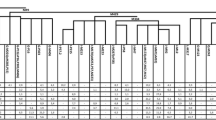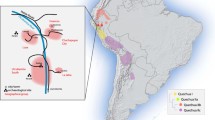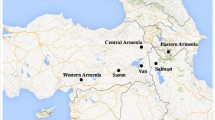Abstract
The possible factors involved in the generation of the p49a,f TaqI Y-chromosome spatial diversity in Egypt are explored. The object is to consider explanations beyond those that emphasize gene flow mediated via military campaigns within the Nile corridor during the dynastic period. Current patterns of the most common variants (V, XI, IV) have been suggested to relate to Middle Kingdom and New Kingdom political actions in Nubia, including sometimes settler colonization, and the conquest of Egypt by Napata (in upper Nubia, northern Sudan) that initiated Dynasty XXV. Other events or processes have not been presented. However, a synthesis of evidence from archaeology, historical linguistics, texts, the distribution of haplotypes outside of Egypt, and some demographic considerations, lends greater support to the establishment, before the Middle Kingdom, of the observed distributions of the most prevalent haplotypes: V, XI, and IV. It is suggested that the pattern of diversity for these variants in the Egyptian Nile Valley, was largely the product of population events that occurred in the late Pleistocene to mid-Holocene through Dynasty I, and was sustained by continuous smaller scale bi-directional migrations/interactions. The higher frequency of V in Ethiopia than in Nubia or upper (southern) Egypt, has to be taken into account in any discussion of variation in the Nile Valley, especially in the context of the findings of historical linguistics.
Les facteurs possibles qui etaient parmi la generation de p49a,f TaqI Y-divers chromosome spatiale en Egypte, avaient ete explores. L’objectif etait de prendre en consideration les explications autour de celles qui mettaient l’accent sur le gene flow qui avait ete medie a partir des campagnes militaries dans le corridor du Nil, pendant la periode dynastique. Les modeles courants des varieties communes (V, XI, IV) avaient ete suggeres pour qu’ils soient en lien avec les actes politiques du Royaume Moyen et du Royaume Nouveau de Nubie, inclu quelques colonies, et la conquete de l’Egypte par Napta (en Haut Nubie, au Nord du Soudan), cela avait initie la 25eme dynastie. D’autres evenements ou procedures, n’avaient pas ete presentes. Ainsi, une synthese d’evidence de l’archeologie, de langues historiques, de textes, la distribution des haplotypes en dehors de l’Egypte, et quelques considerations demographiques avaient servi de grand support a l’etablissement, avant le Royaume Moyen, des distributions observees des varietes les plus prevalents: V, XI, and IV. Il est suggere que le modele de diversite pour ces varieties dans la Vallee du Nil Egyptien, etait largement le produit des evenements populaires qui s’etaient passes dans la derniere periode du Pleistocene au Moyen-Holocene jusqu’a la Premiere Dynastie, et etait soutenu par de petites echelles continue de demi-migrations/interactions directional. La plus grande frequence de V en Ethiopie qu’en Nubie ou plus haut, au Sud de l’Egypte, doit etre prise en considerartion dans n’importe quelle discussion de variation dans la Vallee du Nil, speciallement dans le contexte des decouvertes de langues historiques.
Similar content being viewed by others
References
Adams, B. (1996). Elite graves at Hierakonpolis. In Spencer, J. (ed.), Aspects of Early Egypt, British Museum Press, London, pp. 1–15.
Al-Zahery, N., Semino, O., Benuzzi, G., Magri, C., Passarino G., Torroni A., and Santachiara-Benerecetti, A. S. (2003). Y chromosome and mtDNA polymorphisms in Iraq, a crossroad of the early human dispersal and of post-Neolithic migrations. Molecular Phylogenetics and Evolution 28(3): 458–472.
Angel, J. L. (1972). Biological relationships of Egyptian and eastern Mediterranean populations during the pre-dynastic and dynastic times. Journal of Human Evolution 1: 307–313.
Bard, K. (1994). From Farmers to Pharaohs. Mortuary Evidence for the Rise of Complex Society, Edinburgh University Press, Edinburgh.
Bar-Yosef, O. (1987). Pleistocene connexions between African and southwest Asia. African Archaeological Review 5: 29–30.
Bender, L. (1975). Omotic: A New Afro-Asiatic Language Family. Carbondale, University Museum, Southern Illinois University.
Blench, R. (1993). Recent developments in African language classifications and their implicationsfor prehistory. In Shaw, T., Sinclair, P., Andah, B., and Okpoko, A. (eds.), The Archaeology of Archaeology: Food, Metal and Towns. Routledge, New York, pp. 126–137.
Bosch, E. Calafell, F. Comas, D. Oefner, P. Underhill, P. A., and Bertranpetit, J. (2001). High-resolutionanalysis of human Y-chromosome variation shows a sharp discontinuity and limited gene flowbetween northwestern Africa and the Iberian peninsula. American Journal of Human Genetics 68:1019–1029.
Butzer, K. W. (1976). Early Hydraulic Civilization in Egypt, University of Chicago, Chicago.
Braudel, F. (1982). On History (translated by Sarah Matthews), University of Chicago, Chicago.
Cruciani, F., Santoamazza, P., Shen, P., Macaulay, V., Moral, P., Olckers, A., Modiano, D., Holmes, S., Destro-Bisol, G., Coia, V., Wallace, D., Oefner, P., Torroni, A., Cavalli-Sfrorza, L., Scozzari, R., and Underhill P. (2002). A back migration from Asia to sub-Saharan Africa is supported by high- resolution analysis of human y-chromosome haplotypes. American Journal of Human Genetics 70: 1197–1214.
Cruciani, F. La Fratta, R. Santolamazza, P. Selitto, D., Pascone, R., et al. (2004). Phylogeographic analysis of haplogroup E3b (E-215) Y chromosomes reveals multiple migratory events within and out of Africa. American Journal of Human Genetics 74: 1014–1022.
Diakonoff, I. M. (1981). Earliest Semites in Asia, Altorientalische, Forschungeon.
Diakonoff, I. M. (1998). The Earliest Semitic society. Linguistic data. Journal of Semitic Studies 4 (3): 209–19.
Ehret, C. (1984). Historical/linguistic evidence for early African food production. In Clark, J. D., and Brandt, S. (eds.), From Hunters to Farmers, University of California Press, Berkeley, pp. 26–36.
Ehret, C. (1988). Language change and the correlates of language and ethnic shift. Antiquity 62: 564–574.
Ehret, C. (1993). Nilosaharans and the Saharo-Sudanese Neolithic. In Shaw, T., Sinclair, P., Andah, B., and Okpoko, A. (eds.), The Archaeology of Africa: Food, Metal, and Towns, Routledge, London, pp. 104–125.
Ehret, C. (1995). Reconstructing Proto-Afroasiatic (Proto-Afrasian): Vowels, Tone, Consonantsand Vocabulary, University of California Press, Berkeley, p. 126.
Ehret, C. (2000). Language and history. In Heine, B., and Nurse, D. (eds.), African Languages, An Introduction, Cambridge University Press, Cambridge, pp. 272–297.
Emery, W. B. (1961). Archaic Egypt, Penguin, London.
Fix, A. (1999). Migration and Colonization in Human Microevolution, Cambridge University Press, Cambridge, UK.
Fleming, H. (1974). Omotic as an Afroasiatic family. Studies in African Linguistics, Supplement 5: 81–94.
Gardiner, A. (1961). Egypt of the Pharaohs, Oxford University Press, Oxford.
Greenberg, J. (1966). The Languages of Africa, Indiana University Press, Bloomington.
Greenberg, J. H. (1973). African languages. In Skinner, E. P. (ed.), Peoples and Cultures of Africa, Doubleday, Garden City, NY, pp. 34–58.
Hammer, M., and Zegura, S. (2002). The human Y chromosome haplogroup tree: Nomenclature and phylogeography of its major divisions. Annual Review of Anthropology 31: 303–321.
Hammer, M. F., Redd, A. J., Wood, E. T., Bonner, M. R., Jarjanazi, H., Karafet, T., Santachiara-Benerecetti, S., Oppenheim, A., Jobling, M. A., Jenkins, T., Ostrer, H., and Bonne-Tamir, B. (2000). Jewish and Middle Eastern non-Jewish populations share a common pool of Y-chromosome biallelic haplotypes. Proceedings of National Academy of Science United States of America 97: 6769–6774.
Hassan, F. (1988). The predynastic of Egypt. Journal of World Prehistory 2: 135–185.
Hoffman, M. (1982). The Predynastic of Hierakonpolis, and Interim Report. Egyptian Studies Publication No 1. Giza and Macomb, Illinois: Cairo University Herbarium and Western Illinois University.
Kobusiewicz, M. (1992). Neolithic and predynastic development in the Egyptian Nile Valley. In Klees, F., and Kuper, R. (eds.), New Light on the Northeast African Past, Heinrich-Barth Institut, Koln, pp. 207–218.
Krings, M., Salem, A. E., Bauer, K., Geisert, H., Malek, A. K., Chaix, L., Simon, C., Welsby, D., Di Rienzo, A., Utermann, G., Sajantila, A., Paabo, S., and Stoneking, M. (1999). MtDNA analysis of Nile River Valley populations: A genetic corridor or a barrier to migration? American Journal of Human Genetics 64: 1166–1176.
Kroeper, K. (1996). Minshat Abu Omar-burials with palettes. In Spencer, J. (ed.), Aspects of Early Egypt, British Museum Press, London, pp. 70–91.
Lucotte, G., and Loirat, F. (1999). Y-chromosome DNA haplotype 15 in Europe. Human Biology 71: 431–437.
Lucotte, G., and Mercier, G. (2003a). Y-chromosome haplotypes in Egypt. American Journal of Physical Anthropology 121: 63–66.
Lucotte, G., and Mercier, G. (2003b). Y chromosome DNA haplotypes in Jews: Comparisons with Lebanese and Palestinians. Genetic Testing 7(1): 67–71.
Lucotte, G., and Smets, P. (1999). Origins of Falasha Jews studied by haplotypes of Y chromosome. Human Biology 71(6): 989–993.
Lucotte, G., Sriniva, K. R., Loirat, F., Hazout, S., and Ruffie, J. (1990). The p49/ Taq I Y-specific polymorphisms in three groups of Indians. Genetic Geography 4: 21–28.
Lucotte, G., Smets, P., and Ruffie, J. (1993). Y-chromosome-specific haplotype diversity in Ashkenazicand Sephardic Jews. Human Biology 65(5): 835–840.
Lucotte, G., David, F., and Berriche, S. (1996). Haplotype VIII of the Y chromosome is the ancestral haplotype in Jews. Human Biology 68(2): 467–471.
Lucotte, G., Aouizerate, A., and Berriche, S. (2000). Y-chromosome DNA haplotypes in North African populations. Human Biology 72(3): 473–480.
Lucotte, G., Gerard, N., and Mercier, G. (2001) North African genes in Iberia studied by Y-chromosome DNA haplotype V. Human Immunology 62: 885–888.
Luis, J. R., Rowold, D. J., Regueiro, M., Caeiro, B., Cinnoglu, C., Roseman, C., Underhill, P. A., Cavalli-Sforza, L. L., and Herrera, R. J. (2004). The Levant versus the Horn of Africa: Evidence for bi-directional corridors of human migrations. American Journal of Human Genetics 74 (3): 532–544.
Manni, F., Leonardi, P., Barakat, A., Rouba, H., Heyer, E., Klintshcar, J., McElreavey, K., and Quintana-Murci, L. (2002). Y chromosome analysis in Egypt suggests a genetic regional continuity in northeastern Africa. Human Biology 74(5): 645–658
Midant-Reynes, B. (2000). The Prehistory of Egypt, from the First Egyptians to the First Pharaohs, Blackwell, Oxford.
Munro-Hay, S. (1991). Aksum: An African Civilization of Late Antiquity, EdinburghUniversity, Edinburgh.
Nebel, A., Landau-Tasserot, E., Filon, D., Oppenheim, A., and Faerman, M.(2002). Genetic evidence forthe expansion of Arabian tribes into the southern Levant and North Africa. American Journal of Human Genetics 70: 1594–1596.
Needler, W. (1984). Predynastic and Archaic Egypt in the Brooklyn Museum, Brooklyn Museum, Brooklyn.
Nichols, J. (1997). Modeling ancient population structures and movement in linguistics. Annu Rev Anthropol 26: 359–384.
Passarino, G., Semino, O., Magri, C., Al-Zahery, N., Benuzzi, G., Quintana-Murci, L., Andellnovic, S., Bulle-Jakus, F., Liu, A., Arslan, A., and Santachiara-Benerecetti, A. S. (2001). The 49a,f haplotype 11 is a new marker of the EU19 lineage that traces migrations from northern regions of the Black Sea. Human Immunology 62(9): 922–932.
Ruhlen, M. (1987). A guide to the World’s Languages, Vol. 1. Classification, Stanford University Press, Stanford.
Sanchez, J. J., Borsting, C. Hallenberg, C. Hernandez, A. Morling, N. (2003). Y chromosome analysis of the Somali population suggests the origin of haplogroup E3b1. Poster presentation at Second Interntational Symposium: DNA Polymorphisms in Human Populations. December 5–6. Musee de l’Homme. Paris.
Santichiara-Benerecetti, A. S., Semino, O., Passarino, G., Torroni, A., Brdicka, R., Fellous, M., Modiano, G. (1993). The common, Near Eastern origin of Ashkenazi and Sephardi Jews supported by Y-chromosome similarity. Annals of Human Genetics 57: 55–64.
Semino, O., Santachiara-Benerecetti, A. S., Falaschi, F., Cavalli-Sforza, L. L., and Underhill, P. (2002). Ethiopians and Khoisan share the deepest clades of the human Y-chromosome phylogeny. American Journal of Human Genetics 70: 265–268.
Semino, O., Magri, C., Benuzzi, G., Lin, A., Al-Zahery, N., Battaglia, V., Maccioni, L., Triantaphyllidis, C., Shen, P., Oefner, P. J., Zhivotovsky, L. A., King, R., Torroni, A., Cavalli-Sforza, L. L., Underhill, P. A., and Santachiara-Benerecetti, A. S. (2004). Origin, diffusion, and differentiation of Y-chromosome haplogroups E and J: Inferences on the neolithitization of Europe and later migratory events in the Mediterranean area. American Journal Human Genetics 74(5): 1023–1034.
Trigger, B. (1976). Nubia, Under the Pharaohs, Westview Press, Boulder.
Underhill, P. A., Passarino, G., Lin, A. A., Shen P., Lahr, M. M., Foley, R. A., Oefner P. J., and Cavalli-Sforza L. L. (2001). The phylogeography of Y chromosome binary haplotypes and the origins of modern human populations. Annals of Human Genetics 65: 43-62.
Wendorf, F., and Schild, R. (1980). Prehistory of the Eastern Sahara, Academic Press. New York.
Wendorf, F., and Schild, R., and Associates (2001). Holocene Settlement of the Egyptian Sahara, Vol I. The Archaeology of Nabta Playa, Plenum, New York.
Wetterstrom, W. (1993). Foraging and farming in Egypt: The transition from hunting and gatheringto horticulture in the Nile Valley. In Shaw, T., Sinclair, P., Andah, B., and Okapoko, A. (eds.), The Archaeology of Africa: Food, Metal and Towns, Routlege, New York, pp. 165–226.
Wilkinson, T. A. H. (1999). Early Dynastic Egypt, Routledge, London.
Williams, B. B. (1986). Excavations Between Abu Simbel and the Sudan Frontier. The A-Group Royal Cemetery at Qustul: Cemetery L, Oriental Institute of the University of Chicago, Chicago.
Author information
Authors and Affiliations
Corresponding author
Rights and permissions
About this article
Cite this article
Keita, S.O.Y. Explanation of the Pattern of P49a,f TaqI RFLP Y-Chromosome Variation in Egypt. Afr Archaeol Rev 22, 61–75 (2005). https://doi.org/10.1007/s10437-005-4189-4
Issue Date:
DOI: https://doi.org/10.1007/s10437-005-4189-4




